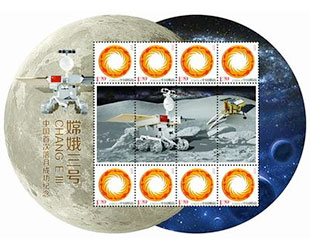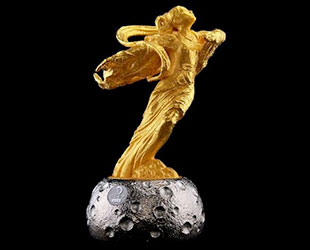Jan. 3, 2014 – China's postal service and largest bank are marking the country's first moon landing by launching new stamps and medallions featuring the Chang'e-3 probe and Yutu rover.
China Post Wednesday (Jan. 1) released its second set of postage stamps commemorating the lunar mission, which on Dec. 14 marked the first moon landing in 37 years.
The latest issue, a double pane titled "In Commemoration of China's First Moon Landing," show the Chang'e 3 lander and six-wheeled Yutu ("Jade Rabbit") rover opposite each other as part of a panoramic design spanning the two 1.2 and 1.5 yuan stamps.
In December, China Post also introduced souvenir sheets featuring the spacecraft and lander as a part of the artwork surrounding, but not appearing on the stamps (also known as the "selvage"). The postage stamps came packaged in folders printed with the rover's image.
Both the December and Jan. 1 commemorative sets use artwork of the Chang'e-3 and Yutu, rather than the photos returned by the two spacecraft from the moon. In the days following the landing, the lander and rover separated and then captured images of each other.

In December, China Post launched a series of Chang'e-3 mission franchised postal products to mark the lunar landing. (China Post) |
The lander and rover are now "sleeping" through the lunar night, a period lasting about two weeks that began on Dec. 26. Dormant due to plummeting temperatures, the solar-powered spacecraft are outfitted with nuclear radioisotope heater units to keep warm.
Once awakened, the Yutu rover will resume exploring the surface, using its sensor-tipped robotic arm and onboard spectrometers and ground-penetrating radar to explore the composition of the lunar soil. The mission is designed to last about three lunar days, or three months on Earth, but could be extended.
The stamps, which were produced by the Beijing Stamp Company, were issued by the China Post in cooperation with the China National Space Administration (CNSA).
The CNSA also worked with the Industrial and Commercial Bank of China (ICBC) to offer a series of precious metal products honoring the Chang'e 3 mission.
The "Lunar Probe" products, which include a gold statue of the moon goddess Chang'e and bricks or medals made of silver and gold, are part of an national outreach effort to excite the Chinese public about space exploration.

Sculptor Yuan Xikun crafted this gold statue of the Chinese moon goddess Chang'e as part of ICBC's Lunar Probe products. (ICBC) |
The sculpture, crafted by artist Yuan Xikun, is inlaid with recovered pieces of debris from the Long March 3B rocket that launched the Chang'e-3 mission on Dec. 1.
"The debris is the only recyclable element in China's lunar program," said Wang Jingdong, ICBC deputy governor, as reported by the China Internet Information Center.
Partial proceeds from the sale of the sculpture and medals will go toward China's future lunar exploration projects and public education, according to ICBC.
In addition to the stamps and the precious metal products honoring the mission, a number of different scale models of the Chang'e-3 lander and Yutu rover have also gone on sale in China.
